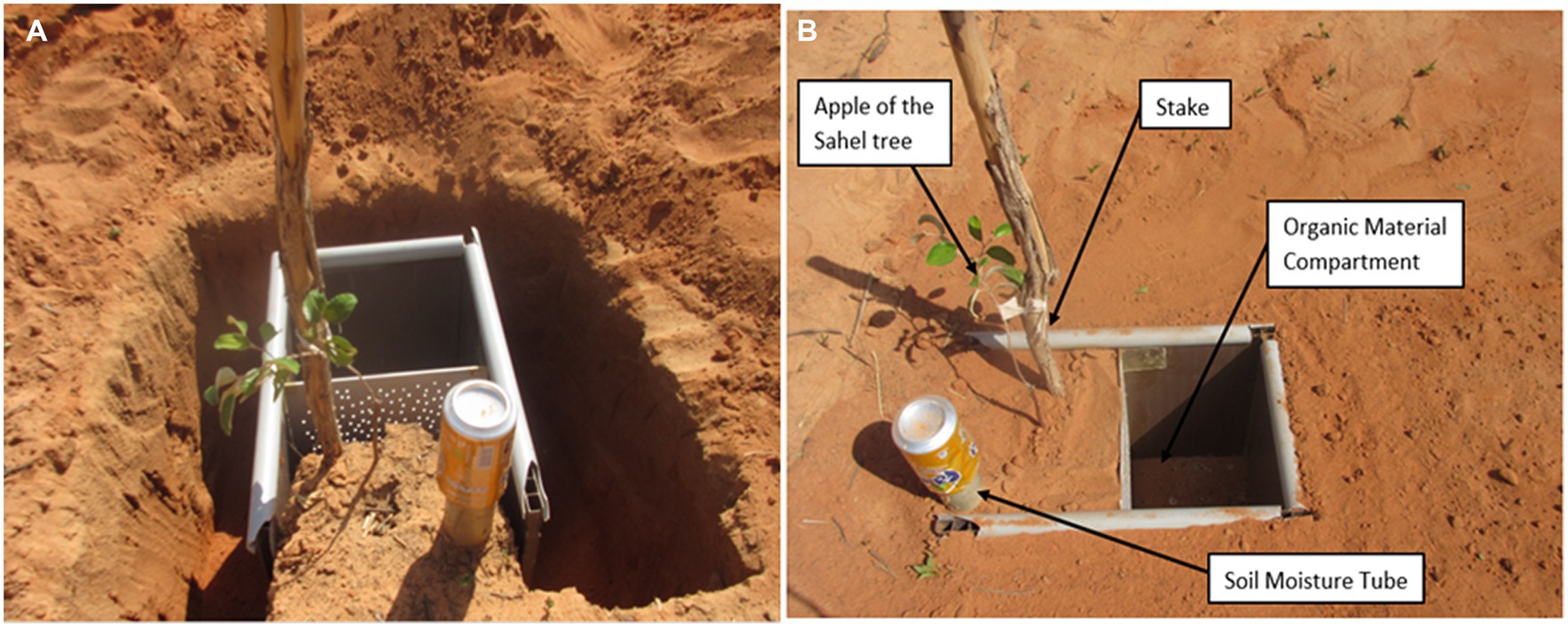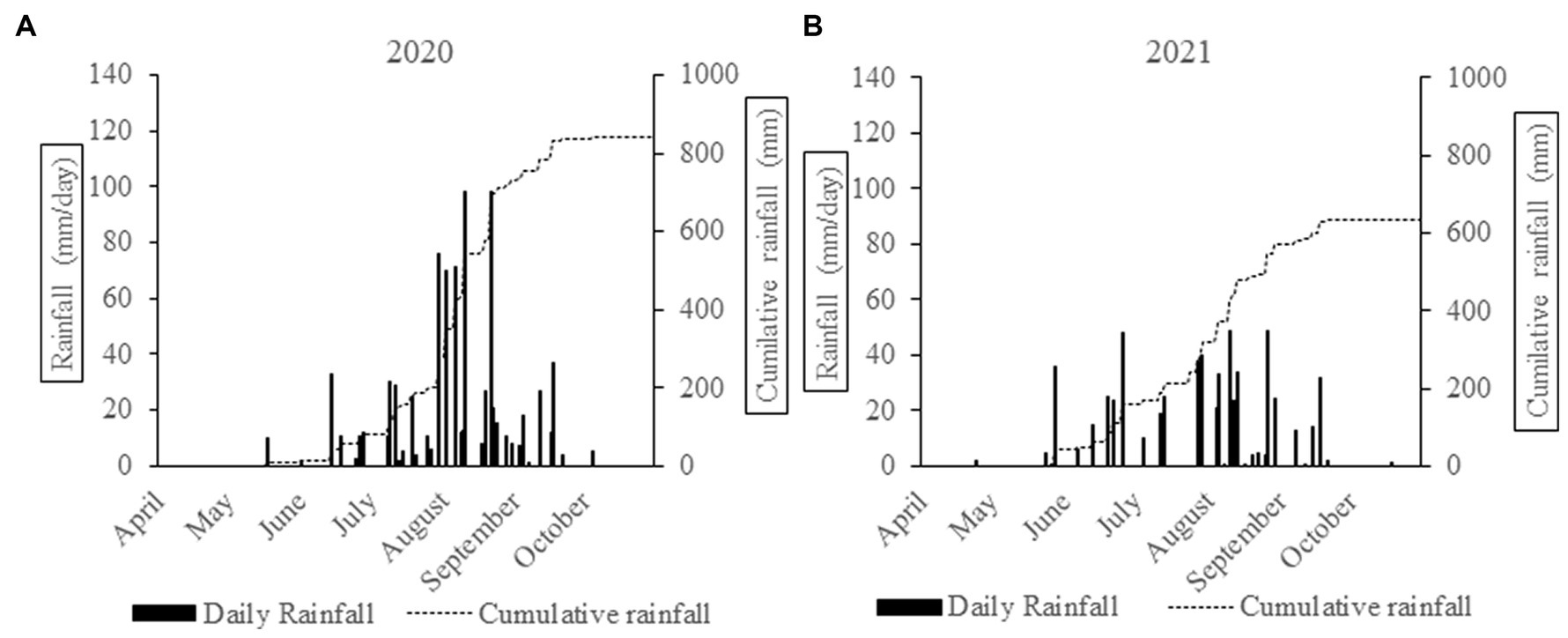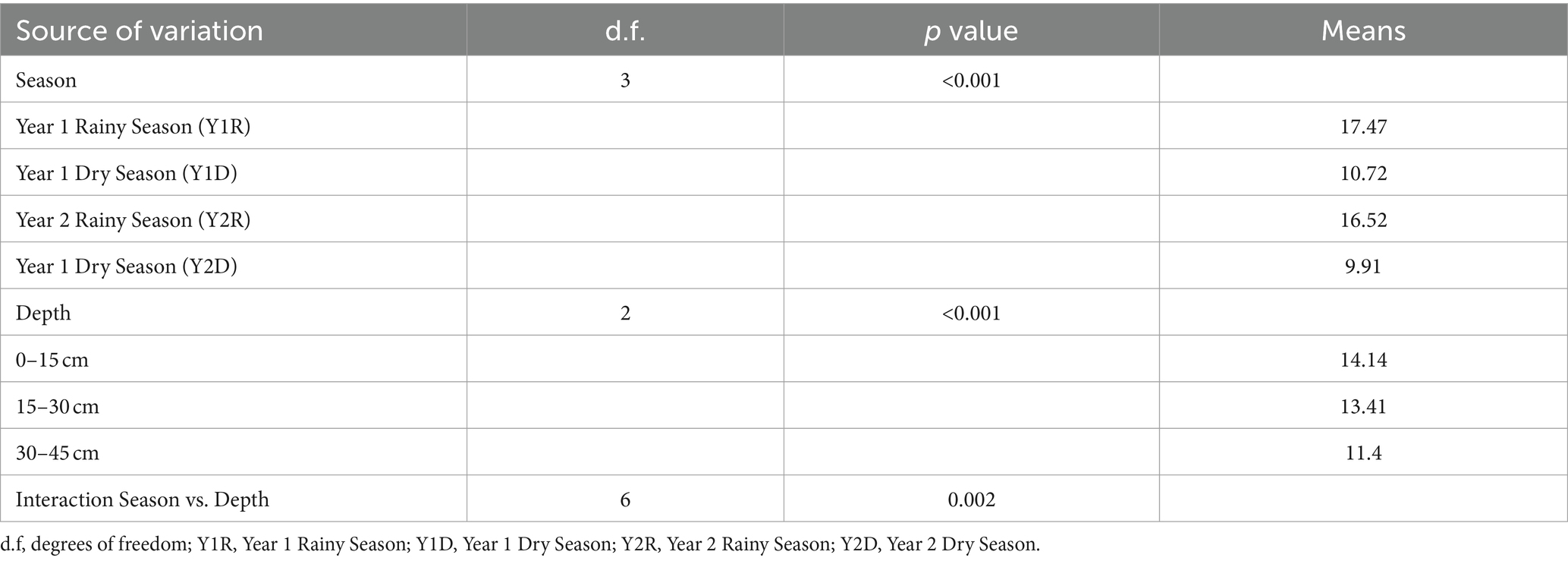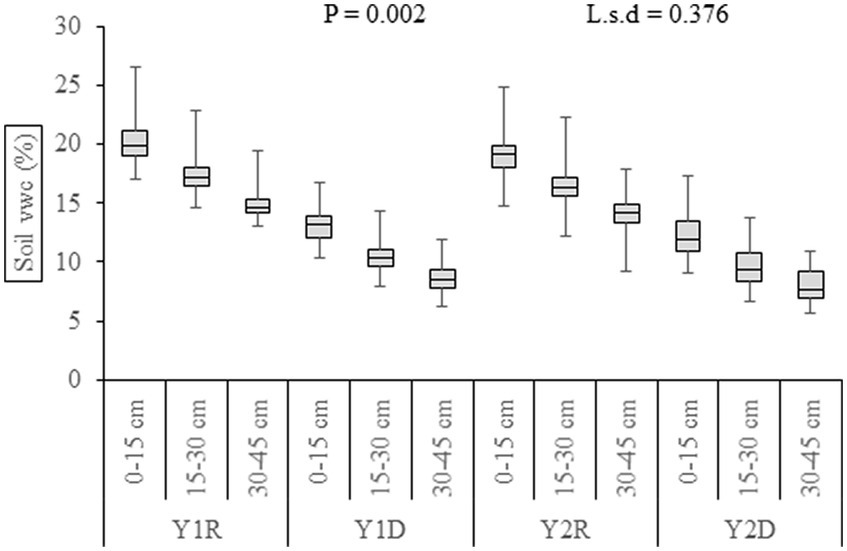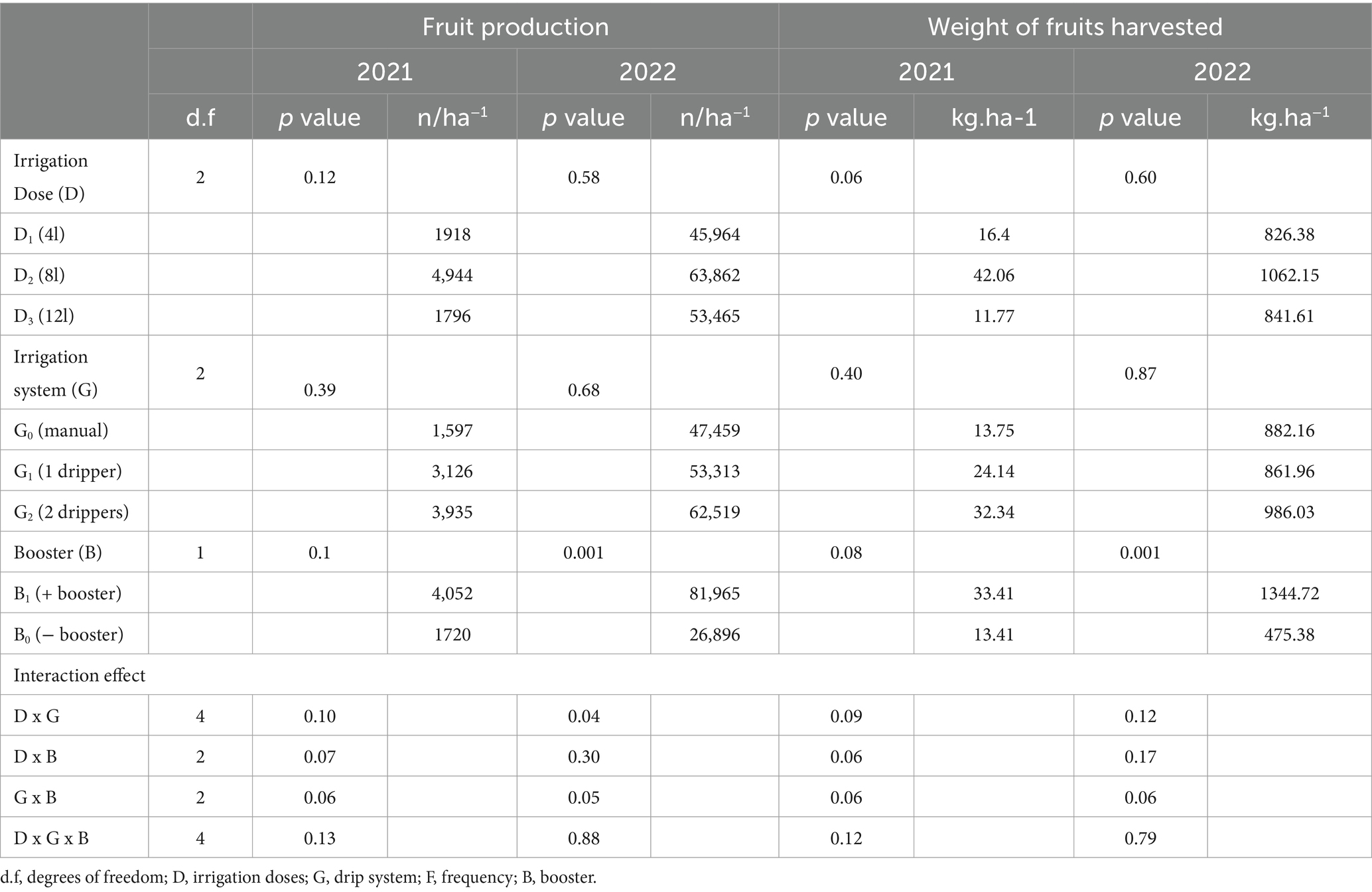Low-cost small-scale irrigation for developing an agroforestry system in the semi-arid zone of Niger: case of the apple of the Sahel (Ziziphus mauritiana L.)
- 1International Crops Research Institute for the Semi-Arid Tropics (ICRISAT), Niamey, Niger
- 2Institut D’Economie Rurale (IER-Mali), Koutiala, Mali
- 3Faculty of Science and Technique, University Dan Dicko Dankoulodo of Maradi (UDDM), Maradi, Niger
- 4Faculty of Science and Techniques, Abdou Moumouni University. BP, Niamey, Niger
- 5International Crops Research Institute for the Semi-Arid Tropics (ICRISAT), Bulawayo, Zimbabwe
Cultivation of the ‘Apple of the Sahel’ (also known as Indian Jujube) is central to the food security, nutrition, and income of rural communities in developing countries like Niger. However, rainfall variability significantly impacts the development of this plant. This study aims to determine the effects of seasonal water regimes on the growth and productivity of the Apple of the Sahel. The trials were conducted in 2020 and 2021 during the rainy and dry seasons at the International Crops Research Institute for the Semi-Arid Tropics (ICRISAT) experimental site in Sadore, Niamey, Niger. The experiment was arranged in a factorial design with three irrigation doses (D) and three irrigation systems (G) as main and subplot factors, respectively. The sub-subplot factors were irrigation frequencies (F) and growth boosters (B), each with two levels. In the dry season, irrigation dose application significantly (p = 0.001) increased soil volumetric water content (vwc). A similar increase in soil vwc was achieved under small-scale drip irrigation with an application of the same dose of organic material (p = 0.001). The diameter of the Apple of the Sahel trees significantly increased (p = 0.03) under the small-scale drip irrigation systems with 6.72 mm recorded under the two-drip irrigation system (G2) as compared with the manual system (G0). In the dry season, the total fruit harvest of Apple of the Sahel recorded had increased (p = 0.04) under the irrigated system, varying from 112 to 246% depending on the number of drippers, and compared to the manual system. These results highlight that small-scale drip irrigation should be used in combination with appropriate water and fertilizer management to improve water availability and tree yield in agroforestry systems in arid regions such as Niger.
1 Introduction
In Niger, a Sahelian country located in West Africa’s Sudano-Sahelian zone, the agro-silvo-pastoral sector employs more than 80% of the population. Hence, it is considered to be the most significant sector and the primary source of income for the majority of the population (FAO, 2017). Farming is dominated by family farms where subsistence agriculture and dryland farming are mostly practiced. The major crops grown include pearl millet (Pennisetum glaucum L.), cluster bean [Cyamopsis tetragonoloba (L.) Taub.], and rice (Oryza sativa L.). However, these sectors are heavily impacted by climatic hazards and the pressure of an increasing population, leading to the continuous degradation of natural resources and limiting their potential to increase and sustain their contribution to family food security (Traore et al., 2015; FAO, 2017; Nord et al., 2022). To reverse this problematic trend, some essential change within the sector is required, such as implementing initiatives to establish a more integrated agricultural sector focusing on the development of manpower employment, food self-sufficiency, and the production of feedstock for both domestic use and export. Nonetheless, the introduction of high-value fruit trees in the Sudano-Sahel rain-fed agroforestry production system could help improve farmers’ income as part of their annual crop production system (Leakey et al., 2005, 2017). Despite the reported benefits, the rate of agroforestry adoption in the Sudano-Sahelian zone remains relatively low (Zougmoré et al., 2018).
In Niger, integrating trees with high socioeconomic and environmental value into the landscape plays vital social and economic functions, including the provision of goods and services for small-scale farmers (Adamou, 2009; Ibrahim et al., 2015b; Rabiou et al., 2017). Ziziphus mauritiana L, also known as the ‘Apple of the Sahel’ or ‘Pomme du Sahel’ in French, and commonly referred to as the Indian Jujube or Indian Plum, is a multipurpose small tree species belonging to the Rhamnaceae family, varying in form from shrubs to small- or medium-sized trees that can be erect, semi-erect, or spreading. This species is typically cultivated in the dry regions of Africa and South Asia (Pasternak et al., 2009). It is commonly cultivated in salt-affected arid and semi-arid areas for its nutritious fruits, leaves, and wood (Singh and Meghwal, 2020). To cope with salinity stress, the Apple of the Sahel uses adaptive mechanisms such as enhanced root growth for water uptake (Ramoliya and Pandey, 2007), Na + exclusion (Gupta et al., 2002), maintenance of leaf turgidity (Nejat and Sadeghi, 2012), increased accumulation of osmolytes such as proline (Abdollahi et al., 2013), and activation of free radical scavenging antioxidant systems (Sengwa et al., 2008). The Apple of the Sahel enables diversified and sustained agricultural production (Bado et al., 2021; Singh et al., 2021). Furthermore, the fruits of the Apple of the Sahel contribute to income generation while improving the productivity and resilience of farming systems (Singh and Meghwal, 2020; Bado et al., 2021). They also contribute to improving household food and nutritional security. Hence, cultivation of the Apple of the Sahel is central to food security, nutrition, and health, and a source of income for smallholder farmers in arid and semi-arid areas (Ganaba et al., 2007; Singh et al., 2021). In the arid and semi-arid zones, smallholder producers generally cultivate crops using traditional practices for crop husbandry, fertility management, and irrigation under the most popular integrated agroforestry/cropping system. It includes growing crops such as pearl millet (Pennisetum glaucum L.), moth beans [Vigna aconitifolia (Jacq.) Marechal], and cluster beans (Cyamopsis tetragonoloba L.) under the Apple of the Sahel trees (Bado et al., 2021; Singh et al., 2021). However, the proper development of this plant is impacted by the variability of soil moisture in the rainy seasons, resulting in poor fruiting (Ibrahim et al., 2015b). Furthermore, the growth dynamics of trees depend on various factors, including the function of species, socioeconomic profile (Singh and Meghwal, 2020; Singh et al., 2021), agro-climatic conditions, and edaphic factors (Ibrahim et al., 2015b; Singh et al., 2021). Therefore, understanding the growth of the Apple of the Sahel is essential for displaying the dynamics of plantations of the species. In arid and semi-arid regions, several studies have been carried out on the socioeconomic aspect of the Apple of the Sahel (Issoufou, 2011; Ibrahim et al., 2015b) and many other aspects such as the inventory of the fruit insects that damage the Apple of the Sahel (Ankoano et al., 2012) in Burkina Faso, the different usages of the species (Sharif et al., 2019; Bussmann et al., 2020), the physical characterization of the fruit properties (Abdel-Sattar et al., 2021), and their medicinal and nutritional values (Aldhanhani et al., 2022).
It has been determined that improving irrigation was one way to undertake successful cultivation of the Apple of the Sahel in arid and semi-arid regions. Yet, the irrigation technologies commonly deployed in the arid and semi-arid zones are still mainly aimed at meeting the needs of large-scale farmers. These included furrow irrigation, drip irrigation, pitcher irrigation, and micro-basin irrigation systems (Postel et al., 2001; Burney, 2012; Singh et al., 2021). Several studies indicate that there is a large potential for poverty alleviation through increased and improved irrigation in small-scale agriculture (Postel et al., 2001; Burney, 2012). However, few studies have focused on the effects of water regimes on the growth of Apple of the Sahel trees using small-scale irrigation systems in the dryland areas. Furthermore, little is known about the growth dynamics of this species to define irrigation systems with better growth performance (height, diameter, and total biomass) in comparison with the current productivity parameters. While research on the optimal effects of irrigation management on the performance of the Apple of the Sahel remains inconclusive, there is a need to identify the most suitable irrigation practices including frequency, duration, and methods for cultivating that tree species.
Conventional drip irrigation facilitates crop cultivation in regions where water scarcity impedes the application of surface irrigation methods. However, drip irrigation has evolved into a knowledge-intensive, technology-oriented operation, primarily designed for larger land holdings and associated with high capital costs. The implementation of conventional drip irrigation systems, due to their cost, complexity, and delicacy, has long been considered too advanced for operation and management by small-scale farmers (Chitsiko and Mudima, 2002). Consequently, smallholder farmers necessitate cost-effective, durable, simple, and low-pressure drip systems to harness the benefits of drip irrigation. This highlights the need to comprehend the effects of the water regime, using affordable and less costly materials, on the growth of the Sahel apple in order to promote its cultivation within agroforestry farming systems. This study aimed to bridge the knowledge gap by (i) understanding the impact of rainfall on soil volumetric water content, (ii) determining the effect of the water regime on soil volumetric water content on the growth of the Apple of the Sahel tree in a semi-arid zone, and (iii) proposing applicable measures to augment the adaptive capacity of Sahel apple tree growers in the region.
2 Methodology
2.1 Experimental site
The trials were conducted from 2020 to 2021 at the International Crops Research Institute for the Semi-Arid Tropics (ICRISAT) experimental site in Sadore, located 45 km from Niamey, Niger, West Africa. The site is situated at 13°15’N and 2°18′E, at an altitude of 240 m. The climate is Sudano-Sahelian, with rainfall varying significantly in time and space, characterized by a 5-month rainy season between June and October, followed by a long dry season (7 months) that dominates the rest of the year. The average annual rainfall and temperature in Sadore from 1983 to 2018 were 560 mm and 29°C, respectively, with a potential evaporation of nearly 2000 mm per year−1 (ICRISAT, climatological database). The soil is highly to moderately acidic: pH 4.5–5.0 (Sanoussi et al., 2020). The main characteristics of this soil are high sand content of more than 85% at 2–8 m depth covering a series of stepped surfaces of cemented lateritic gravel (West et al., 1984; Klaij and Vachaud, 1992), inherent soil fertility with low organic carbon content (0.20% in the upper 40 cm of soil), and low cation exchange capacity (Sanoussi et al., 2020). The soil water content at field capacity is 0.09–0.10 m3-m-3 (Akponikpe et al., 2008). The soil at the experimental site was classified as a sandy Arenosol (West et al., 1984; Klaij and Vachaud, 1992) according to the FAO classification.
2.2 Features of the apple of the Sahel
The apple of the Sahel is a long-known traditional fruit that is commonly referred to as the Indian Jujube or Indian Plum. It belongs to the Rhamnaceae family species and is indigenous to Southern Asia and Eastern Africa. The Apple of the Sahel is widely cultivated throughout the world (Singh et al., 2021). The fruit resembles a small apple in shape, which prompted authors to call it the “Apple of the Sahel” or ‘Pomme du Sahel’ in French (Pasternak et al., 2009). It is semi-deciduous and can reach a height of 3–16 m or more, with many branches (Jin et al., 2018). The leaves, rich in lipids, iron, calcium, magnesium, and zinc, are consumed by both humans and livestock (Danthu et al., 2004). The wood of the Apple of the Sahel is strong and malleable. The barks and roots have a wide range of medicinal uses, and the entire tree can serve as hedges and/or windbreaks. The Apple of the Sahel is tolerant to drought, flooding, salinity, and withering (Clark and Clark, 1999; Singh et al., 2021) and is cultivated in dry regions of Africa (Ouédraogo et al., 2006) and northwestern India (Singh et al., 2021). The fruit, locally called “Magarya Nasara” in Hausa or “Annasara daréy” in Zarma, has been reported to be larger than the local varieties, nutritious, and rich in vitamin C, β-carotene, calcium, and phosphorus content (Yacouba et al., 2018; Sharif et al., 2019; Aldhanhani et al., 2022) and is widely harvested and marketed in the urban and rural areas for human and animal food and income in the West African Sahel (Ouédraogo et al., 2006; Ganaba et al., 2007; Ankoano et al., 2012). To increase the productivity of the Apple of the Sahel tree, pruning is conducted annually in May and the tree can yield fruit from grafted seedlings in the 1st year of planting. Much more significant production begins in the 5th or 6th year, but maximum productivity is reached at 10 years and can continue for almost 40 years (Ganaba et al., 2007).
2.3 Experimental design
The experimental design was a split-split plot arrangement with three replicates. The treatment on the main plots was the type of irrigation dose (D) with three levels (D1 = 4 L; D2 = 8 L; D3 = 12 L). On the subplots, irrigation systems (G) with three levels were tested, referred to as G0 = manual input (control); G1 = 1 dripper; G2 = 2 drippers. There were two factors in the sub-subplot, including irrigation frequencies (F) with two levels (F1 = every 2 weeks and F2 = every 3 weeks) and growth booster (B) with two levels also (B1 = with or B0 = no growth boosters) (Appendix 1). Each plot consists of two rows with a spacing of 8 m with a total of four plants. In total, the experiment included 216 Apple of the Sahel trees: 108 boosters and 144 water containers with drippers (Figures 1, 2).
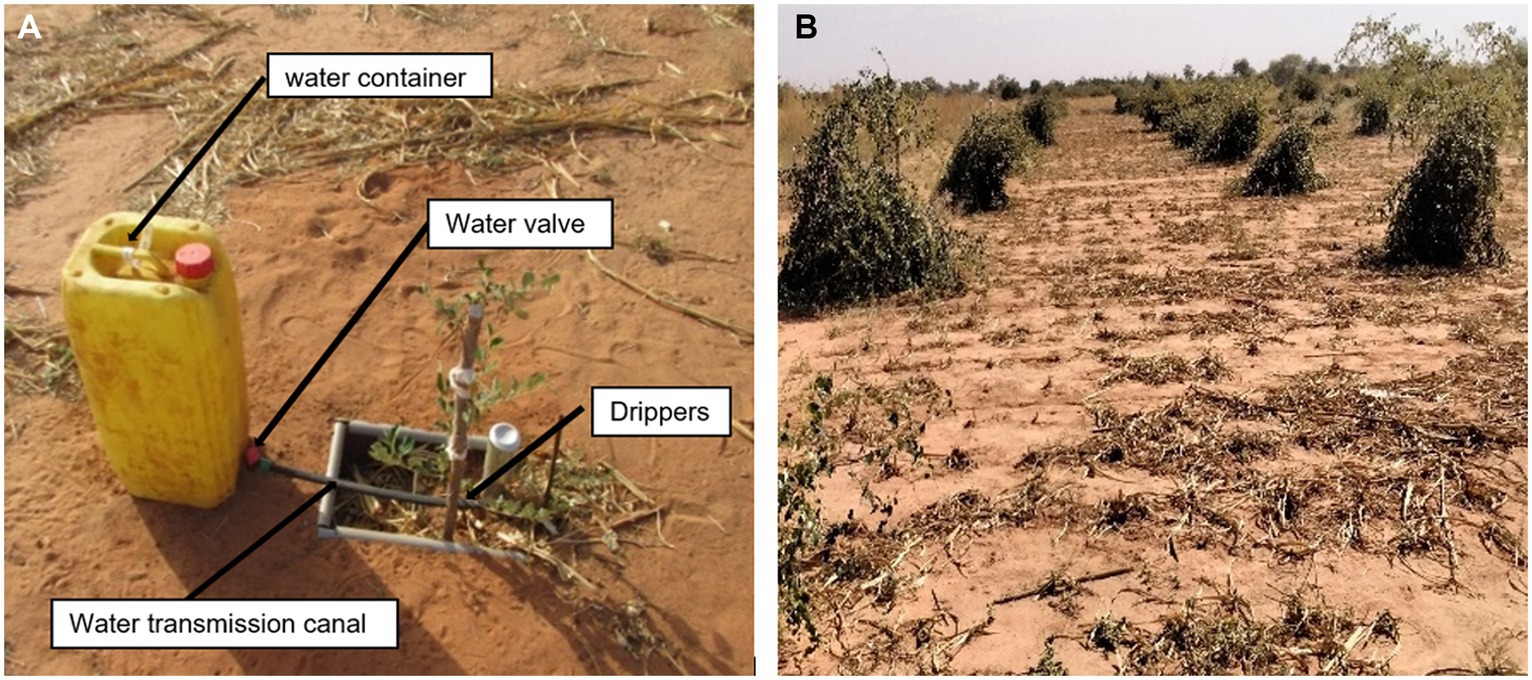
Figure 2. Drip irrigation system components (A) and Apple of the Sahel plants after 2 years of the experiment (B).
2.4 Data collection
2.4.1 Measurement of soil moisture
The irrigation was carried out based on an established schedule. Before applying the different irrigation doses, soil volumetric water content (vwc) was calculated using the neutron probe (Didcot Instrument Company Limited, Station Road Abingdon, Oxon OX143 LD), with data collected weekly from a two-meter-long access tube installed in each experimental plot. All plots underwent measurements performed at 0.15 m intervals at three different levels of the root profile (0–15 cm, 15–30 cm, and 30–45 cm depth). Prior to the measurements, the neutron probe was calibrated in situ (for the soil of the experimental field) using the gravimetric method as described by the manufacturer. Thus, the volumetric soil water content was calculated taking into account the treatment applied with reference to the formula used by Fatondji (2002) as follows:
where θv is volumetric water content (vwc) expressed in %; a is the intercept, and b represents the slope of the equation resulting from the neutron probe calibration curve. From this equation, y is the volumetric soil water content; x is the relative count ratio [ratio of the neuron probe reading in the field (C) to the standard count reading from the access tube installed in pure water (Cs)].
2.4.2 Apple of the Sahel measurement
Aerial biomass was estimated by non-destructive measurements: tree height and stem section measured on the Apple of the Sahel tree for treatment. Simultaneously, nine Apple of the Sahel trees were harvested randomly (Rabiou et al., 2017), including three with large trunk diameters (≥ 25.6 cm), three with medium trunk diameters (12.5 cm ≤ diameter ≤ 25.5 cm), and three with small trunk diameters (1.0 cm ≤ diameter ≤ 12.5 cm), located outside the plots in each field. A linear relationship was established between height as an independent variable and aerial biomass as a dependent variable. The correlation coefficient square was 0.82, and a linear regression model was used to compute the aerial biomass of the recorded trees on the plot (Appendix 2). Growth measurements were started at the beginning of the experiment and every 30 days thereafter. Tree height (m) was measured using a tape ruler, and trunk diameter (cm) was measured using a caliper (Rabiou et al., 2017; Jin et al., 2018; Figures 1, 2).
2.4.3 Data processing and analysis
Prior to the statistical analysis, data were cautiously checked for variance homogeneity and normality. Data were subjected to ANOVA using a General Treatment Structure (for split-split plot block Design) in GENSTAT v.9. Mean separations were performed, and values were compared for significant differences using Duncan’s multiple range tests at a significance level of <0.05.
3 Results
3.1 Rainfall distribution trend
The climate is characterized by a 5-month rainy season that occurs between June and October followed by a lengthy dry season dominating the remainder of the year (Figures 3A,B). Rainfall averages of 842 mm over 37 rainy days and 633 mm over 34 rainy days were recorded for the years 2020 and 2021, respectively. August and September were the wettest months, accounting for half of the total rainfall. October was the driest month, with several dry spells.
3.2 Effect of seasons on soil volumetric water content
As expected, soil vwc at all soil depths was higher in the rainy season than in the dry season (Table 1; Figure 4). In both seasons, soil vwc decreased significantly with increasing soil depth. In addition, as the irrigation system was not applied during the rainy season, soil moisture was uniformly ensured by rainfall across all treatments. Therefore, we opted to concentrate the analysis on the individual effects and interactions during the dry season.
3.3 Effect of treatments on soil volumetric water content at different depths in the dry season
3.3.1 Effect of irrigation doses (D)
In the dry season, the irrigation doses significantly increased (p = 0.001) the soil volumetric water content (vwc) with an average of 9.28 ± 2.02%, 10.42 ± 2.29%, and 11.2 ± 2.22% for D1, D2, and D3, respectively (Table 2). Across depth, an average of 12.79 ± 1.54% and 13.59 ± 1.51% of soil vwc was recorded at the 0–15 cm soil depth for an irrigation dose of 8 L (D2) and 12 L (D3), while 11.61 ± 1.15% was recorded with an irrigation dose of 4 L (D1) at the same soil depth (Figure 5A). This trend decreases with depth, ranging from 10.11 ± 1.39% to 8.37 ± 1.26% for D2 and from 11.01 ± 1.10% to 9.11 ± 1.09% for D3 at depths of 15–30 cm and 30–45 cm, respectively. In contrast, the D1 shows lower soil vwc with measurements of 8.85 ± 0.1% and 7.38 ± 0.8% at depths of 15–30 cm and 30–45 cm, respectively (Figure 5A).
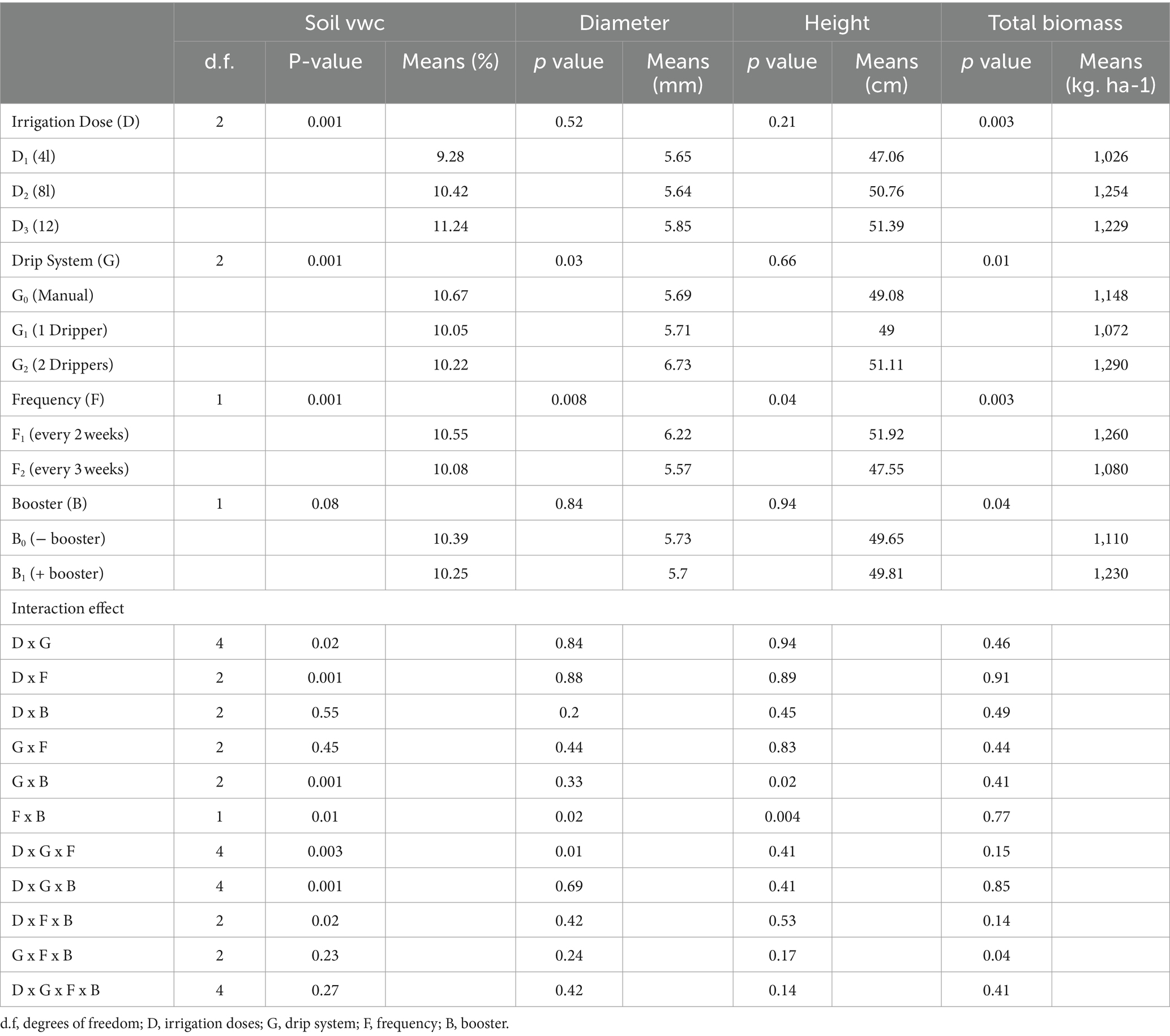
Table 2. ANOVA of dry season soil volumetric water content and apple of the Sahel tree development parameters, p < 0.05.
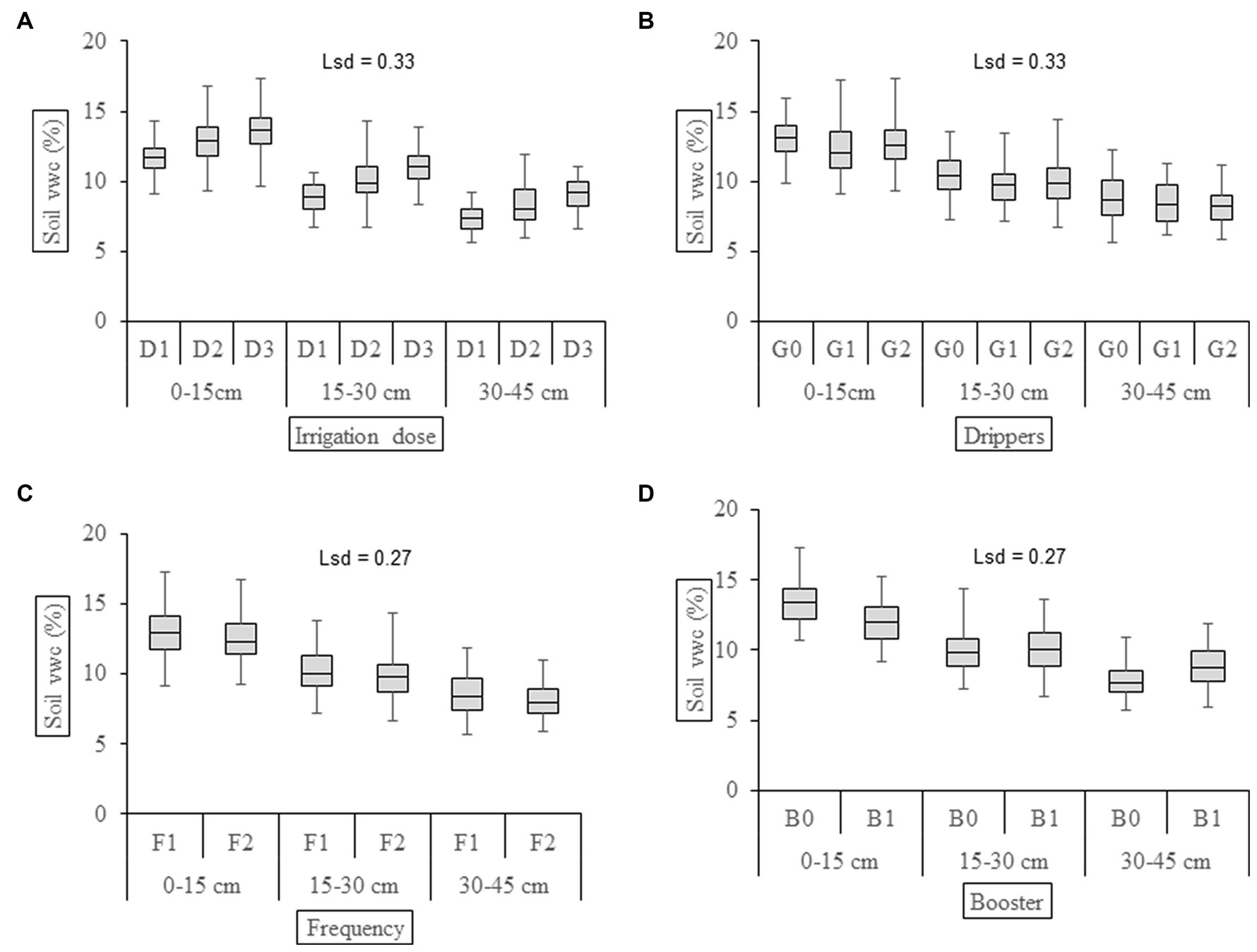
Figure 5. Treatment effect on soil volumetric content at different depths in the dry season. Lsd, least significant difference.
3.3.2 Effect of drip irrigation system (G)
The irrigation system (G0, G1, and G2) influenced the soil volumetric water content (vwc) by significantly increasing (p = 0.001) the soil vwc (Table 2). In the dry season, Figure 5B shows an average of the soil vwc decreased from 12.27 ± 1.7% to 8.17 ± 1.25% for one drip irrigation system (G1). Additionally, at the depths of 0–15 cm, 15–30 cm, and 30–45 cm, the vwc decreased from 12.68 ± 1.6% to 8.11 ± 1.21%. The manual irrigation (G0) shows the most important soil vwc range from 13.03 ± 1.4% to 8.58 ± 1.37% for 0–15 cm, 15–30 cm, and 30–45 cm depths (Figure 5B).
3.3.3 Effect of irrigation frequency (F)
Irrigation frequency significantly (p = 0.001) increased soil volumetric water content (vwc; Table 2) in the dry season. The soil vwc decreases with depth from 13 ± 1.6% to 8.45 ± 1.3% when using F1 (every 2 weeks watering) at soil depths of 0–15 cm, 15–30 cm, and 30–45 cm (Figure 5C). The three-week irrigation frequency (F2) shows the lowest soil vwc from 0–15 cm to 30–45 cm with an average from 12.36 ± 1.5 to 8.11 ± 1.17% (Figure 5C).
3.3.4 Effect of growth booster (B)
At the same depth scale, soil volumetric water content (vwc) did not vary significantly regardless of the presence or absence of the booster (Table 2). However, significant differences were observed between soil depths. The mean value of the soil vwc varied from 13.4 ± 1.5% to 11.9 ± 1.4% at the depth of 0–15 cm compared with 10.02 ± 1.5 and 8% ± 1.3%, respectively, for depths of 15–30 cm and 30–45 cm (Figure 5D).
3.3.5 Effect of treatment interaction (D x G x F x B)
Interaction analysis shows significant relationships between dose, boosters, and frequency (p = 0.02; Table 2). Regardless of whether it is F1 or F2 frequency, the highest level of soil volumetric water content (vwc), 11%, was consistently obtained with the D3 dose, irrespective of the presence or absence of boosters, compared with the lowest value with D1 being less than 9% (Figure 6A). The interaction between irrigation doses (D), irrigation frequencies (F), and irrigation systems (G) indicated that regardless of the irrigation system (G0, G1, or G3) or irrigation frequency (F1 and F2), the highest soil vwc (>12%) was obtained with the D3 dose, while the lowest was obtained with dose D1 (8%; Figure 6B). Furthermore, a similar trend was obtained with the interaction between irrigation dose, booster, and irrigation system (Figure 6C). Except for manual application (G0), the soil vwc was higher without the booster than that with the booster under G1 and G3 (Figure 6C).

Figure 6. Treatment interaction on soil volumetric water content in the dry season. D1: 4L, D2: 8L, D3: 12L, Lsd, least significant difference.
3.4 Effect of treatments on the apple of the Sahel tree development
3.4.1 Plant diameter
The irrigation dose (D1, D2, and D3) had no significant effect (p = 0.52; Figure 7A) on the diameter section of the Apple of the Sahel tree during the dry season. However, with the small-scale drip irrigation system, the diameter of the Apple of the Sahel trees has significantly increased (p = 0.03; Table 2). With an average diameter of 6.73 mm, the two-drip irrigation system (G2) achieved the largest diameter. The manual irrigation system (G0) with 5.69 mm had the smallest trunk diameter (Figure 7B). Irrigation frequency (F) significantly increased (p = 0.008) the diameter of the Apple of the Sahel trees, with the 14-day watering showing the best performance, with an average of F1 = 6.22 ± 0.84 mm. On the other hand, the F2 frequency had the lowest average performance with 5.57 mm (Table 2; Figure 7C). Booster had no significant effect (p = 0.84) on the diameter growth of the Apple of the Sahel trees (Figure 7D). However, a significant interaction effect was observed between irrigation frequency and booster (F x B; p = 0.02) on the diameter of the Apple of the Sahel trees (Table 2), with the largest diameter (6.11 mm) obtained with F1B1 combination compared with the lowest diameter (5.28 mm) with F2B1 (Figure 7E). Furthermore, a significant interaction effect was observed between D x G x F (p = 0.019) on the diameter of the Apple of the Sahel trees (Table 2). The largest plant diameter was obtained with the combination of manual watering combined with D1 (4l) and F1 (D1F1G0), with an average of 6.45 ± 0.15 mm followed by D3F1G2 with an average of 6.15 ± 0.32 mm (Figure 7F).
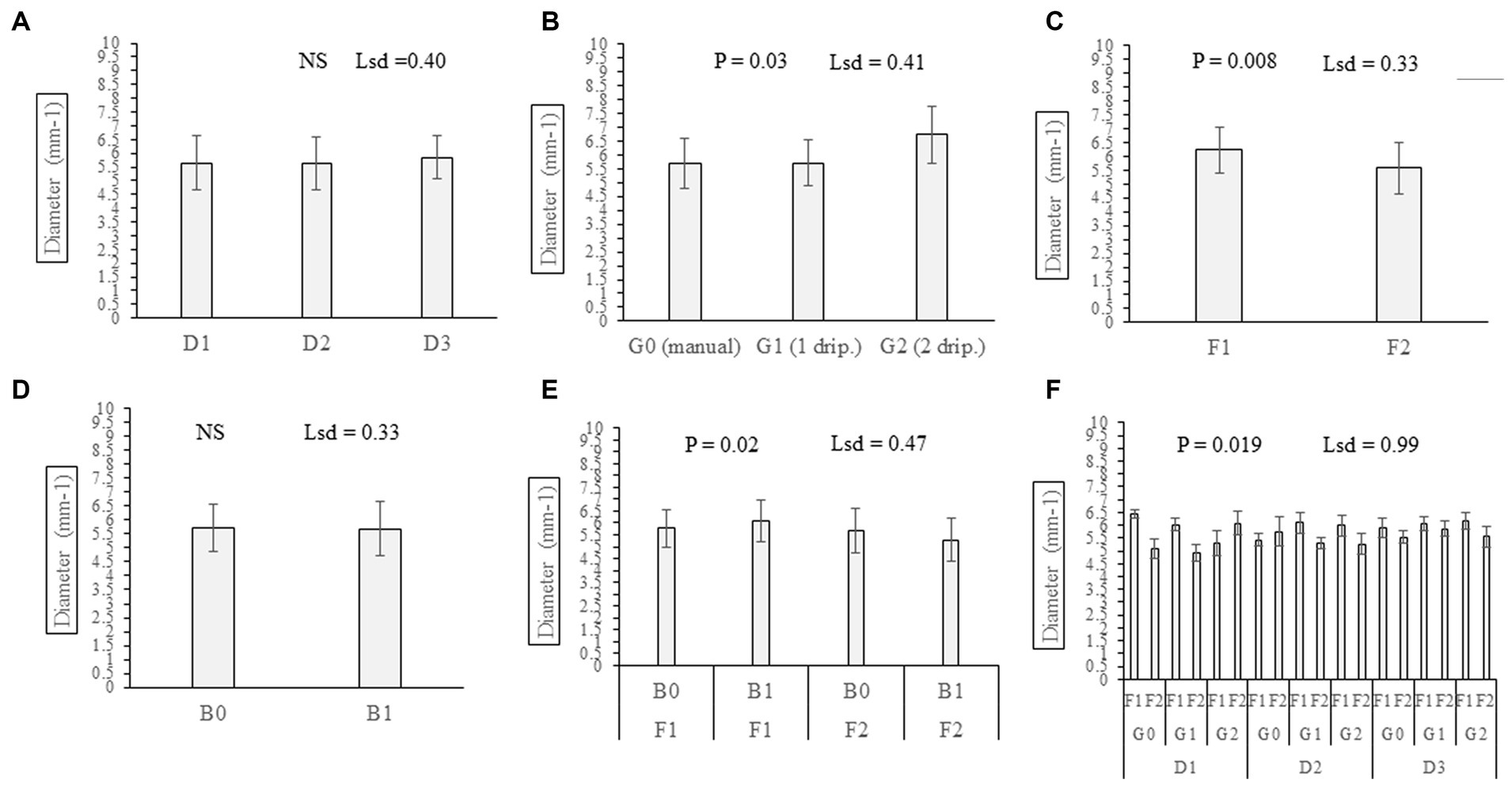
Figure 7. Diameter development of the Apple of the Sahel tree in the dry season. NS, non significant, Lsd, least significant difference.
3.4.2 Plant height
Irrigation dose and irrigation system had no significant direct effect (p = 0.21) on the height of the Apple of the Sahel trees (Table 2; Figure 8A). However, irrigation frequency significantly increased (p = 0.048) the height of the Apple of the Sahel tree (Table 2; Figure 8B), with the highest height of 55.42 cm obtained with F1—watering frequency of 14 days (Figure 8C) while the lowest height was recorded with F2—watering frequency of 21 days with an average height of 46.63 cm (Figure 8C). Booster supplement had no significant effect (p = 0.94) on the height of the Apple of the Sahel tree during the dry season (Figure 8D). The interaction between the booster (B) and the small-scale drip system (G) as well as with irrigation frequency significantly increased the height of the Apple of the Sahel trees (Table 2). The two-dripper irrigation system with booster (G2B1) recorded the highest tree height at 57.4 cm (Figure 8E), while the combination of irrigation frequency and booster resulted in the highest increase with B1F1 (58.7 cm), followed by B0F1 with 52.07 cm (Figure 8F).
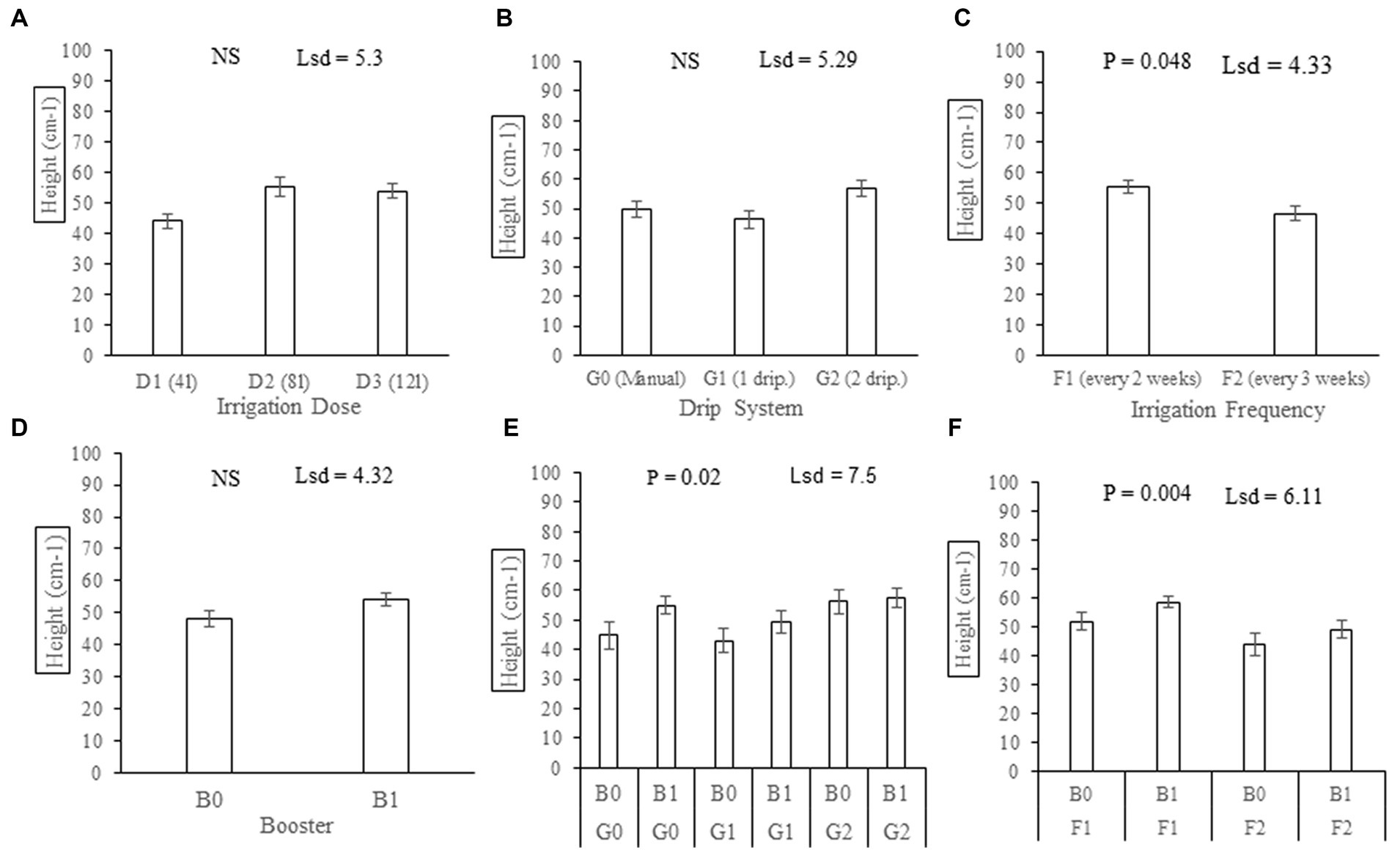
Figure 8. Plant height development of the Apple of the Sahel tree in the dry season. NS, non significant, Lsd, least significant difference.
3.4.3 Total biomass and fruit production
a) Total biomass production of the Apple of the Sahel trees in the dry season
The irrigation dose significantly increased (p = 0.003) the total biomass of the Apple of the Sahel tree (Table 2; Figure 9A). With a total biomass of 1,254 ± 64.6 kg ha−1, D2 produced the highest total biomass, followed by D3 with a total biomass of 1,230 ± 49.9 kg ha−1. The lowest total biomass was obtained under D1 dose, with 1026.4 ± 50 kg ha−1. There was a significant effect (p = 0.01) of drip irrigation system (G; Figure 9B) as well as irrigation frequency (F; Figure 9C; Table 2) on the total biomass. With the irrigation system, the two-dripper small-scale irrigation (G2) recorded the highest total biomass of the Apple of the Sahel tree with 1,290 ± 52.8 kg ha−1 while with the irrigation frequency, F1—every 2 weeks watering achieved the highest total biomass with 180 kg ha−1 of total biomass more than that obtained with F2—21 days watering frequency (Figure 9C). Booster (B) has a significant effect (p = 0.04) on the total biomass of the Apple of the Sahel tree with an increase of 120 kg ha−1 from B1 to no booster (B0) with 1,230 ± 40.2 kg ha−1 and 1,110 ± 51.7 kg ha−1, respectively (Figure 9D). The interaction effect between the small-scale irrigation system (G), irrigation frequency (F), and booster (B) on total biomass production was significant (p = 0.04; Figure 9E), with the most efficient total biomass obtained by combining G2F1B1, yielding 1,416 ± kg ha-1, compared with the manual method G0F1B1, which produced 1,298 ± kg ha−1 of total biomass.
b) Apple of the Sahel fruit production in the dry season
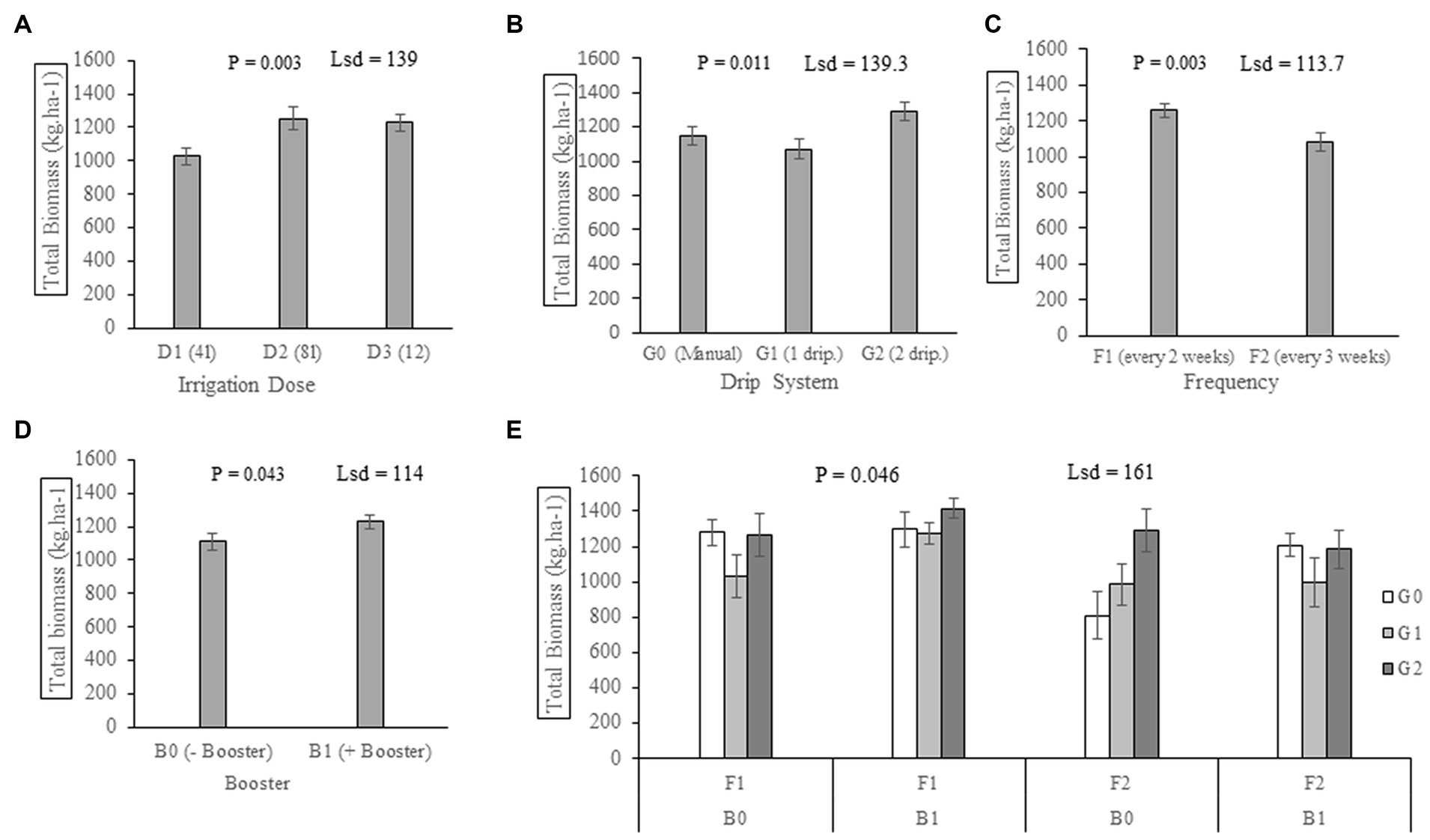
Figure 9. Total biomass of the Apple of the Sahel tree in the season. G0: manual, G1: 1 drip, G2: 2 drips, Lsd, least significant difference.
The small-scale drip irrigation presented higher fruit production with 3,935 fruits ha−1 and 62,519 fruits ha−1 harvested under the G2 dripper system in 2021 and 2022, respectively (Table 3) while, the manual irrigation (G0) obtained the lowest fruit production in both years, with only 1,597 fruits ha−1 and 47,459 fruits ha−1, respectively (Table 3). The total fruit of the Apple of the Sahel trees recorded increased significantly (p = 0.04) with 8 L of water application through a two-dripper irrigation system. The weight of fruit harvested shows the same trend as that of the production in both 2021 and 2022 (Table 3). The two-dripper irrigation system (G2) recorded the highest fruit weight in 2021 and 2022, with 32.34 kg ha−1 and 986.03 kg ha−1, respectively. The application of organic fertilizers (Booster) significantly increased the number and weight (p = 0.001) of apple fruits harvested in both years (Table 3; Appendix 2).
4 Discussion
4.1 Effect of the irrigation system on soil volumetric water content
The inter-annual analysis revealed significant seasonal changes in soil volumetric water content (vwc; dry season vs. rainy season), with soil vwc typically greater during the rainy season. This could be attributed to the large amount of rainfall recorded during the 2-year experiment (2019 and 2021), well above the annual rainfall mean at Sadore (Ibrahim et al., 2015b). Seasonal patterns in soil vwc may thus have significant implications for farming systems in these Sahelian regions with fragile sandy soils and erratic rainfall (Picouet, 2004).
It was found in the dry season that increasing irrigation dose resulted in the largest soil vwc, notably in the top layer of soil (0–15 cm), with a subsequent drop in vwc as depth increased. This decrease from the surface downward can primarily be attributed to the water uptake of the Sahelian Apple root system, which is notably denser in the first 15 cm of soil, particularly 2 years after establishment. Consequently, there is a reduced infiltration of water into the soil horizon at depths of 30 or 45 cm. Additionally, the reduced soil moisture levels could also be influenced by significant evaporation rates, which typically account for up to 65% of water loss (Montieth, 1991; Fox and Rockström, 2000). Such substantial water loss through evaporation limits the available water resources, consequently reducing irrigation potential. Moreover, in the Sahelian region where vegetation is sparse, evaporation directly from the soil surface plays a crucial role in the water balance. Even on cultivated land, soil evaporation during the growing season contributes significantly to water loss (Wallace, 1992).
Our results show that the interaction between irrigation doses (D), irrigation frequencies (F), and irrigation systems (G) indicated that regardless of the irrigation systems (G0, G1, or G3) or irrigation frequency (F1 and F2), the highest soil volumetric water content (vwc) was obtained with the D3 dose than the lowest was obtained with dose D1. However, manual irrigation (G0) shows the most important soil vwc from upper to lower layers. This is attributable to the water application method, where the entire quantity of water is applied at once, leading to a localized increase in soil moisture. However, manual watering is susceptible to various factors, including evaporation and, most importantly, infiltration or runoff (De Fraiture and Giordano, 2014). In contrast, the drip irrigation system offers distinct advantages. By releasing water slowly and uniformly, it ensures a more efficient distribution of water across the soil surface, particularly around the trees, thereby covering a larger area of the tree roots (Postel et al., 2001; Woltering et al., 2011). This slow and homogeneous discharge of irrigation water not only optimizes water usage but also minimizes the risk of water loss due to evaporation or runoff (Descroix et al., 2011). Consequently, the drip system presents a more effective and sustainable approach to irrigation management, especially in contexts where water conservation and maximizing root zone coverage are paramount.
Furthermore, our findings demonstrated that the interaction between irrigation doses, drip irrigation systems, and organic fertilizer application through booster indicated that the highest soil volumetric water content (vwc) was obtained with a higher application dose (D3). Organic fertilizer is indicated to improve soil structure, aggregate stability, infiltration rate (Tanaka et al., 2005; Narayan et al., 2006), and soil vwc (Ibrahim et al., 2015b). However, organic fertilizer changes the flow and soil moisture, hence altering soil water content at the root zone (Cao et al., 2012). Furthermore, many authors highlighted the importance of small-scale drip irrigation and mulch in sustaining soil vwc (Mukherjee et al., 2004).
4.2 Effect of irrigation system on the growth and yield of the apple of the Sahel tree
Our findings indicate that neither irrigation dose nor frequency directly influences the height or diameter of the Apple of the Sahel stems. Instead, the crucial factor appears to be the interaction between the irrigation system and watering frequency, particularly with 14-day intervals. This interaction improves water distribution in the soil profile and uses a small amount of water at low pressure, resulting in lower energy costs (Varma et al., 2006). It also demonstrates the benefit of maintaining soil moisture levels prior to subsequent tree development by creating a cool microclimate over the root system. Furthermore, as the Apple of the Sahel tree is a “cold-season plant,” the cool microclimate aids, particularly in the later stages of fruit formation (Maruza et al., 2017). In this system, water supply in accordance with crop water requirements was maintained through a small-scale drip irrigation system as the water was spread on a frequent and uniform basis (Mmolawa and Dani, 2000; Kang et al., 2004) and provided better soil aeration and a large, wetted root zone led to better crop growth (Ismail et al., 2014). The booster, which offers an adequate amount of mineral fertilizer, also benefits from the positive interaction between the irrigation system and watering frequency. This results in a balanced nutritional environment for optimal tree growth. This combination improves soil aeration and contributes to water and nutrient uptake from the soil, thus promoting total production (Bonachela et al., 2001; Kang et al., 2004; Ismail et al., 2014). Additionally, Pareek et al. (2009) support that water supply and soil nutrient content are the most important factors determining the productivity and quality of Jujube in dry areas. Similarly, Ouédraogo et al. (2006) reported an improvement in Jujube tree height, diameter, and fruit production through the combined application of fertilization and irrigation in Burkina Faso. In addition, compared with manual irrigation, which caused a low increase in tree growth during the dry season, increasing the irrigation dose in combination with a two-dripper irrigation system resulted in a significant increase in tree biomass and fruit production. This aligns with a linear allometric correlation between growth parameters of the tree and indirectly addresses the notion of differential allocation of the biomass produced for tree growth and yield production (King, 2005; Lal and Dhaka, 2007). Additionally, a growth strategy, characterized by the preferential allocation of resources to biomass production, may vary depending on local conditions for a given species (Yamada et al., 2005; Madelaine et al., 2007).
4.3 Challenges and opportunities of the system
Small-scale drip irrigation with locally available water containers is a viable alternative to smallholders’ schemes and an appealing choice for smallholder farmers with little financial means to afford large-scale systems. The system is easy to install, manage, and implement in areas often less than 1 ha. The small-scale drip irrigation system can be used for crop cultivation in areas with insufficient water irrigation systems, and it is up to 90% effective in the field, compared with 60–80% for sprinkler irrigation and 50–60% for overhead irrigation (Woltering et al., 2011). Furthermore, small-scale drip irrigation has the significant advantage of minimizing water loss while producing crops. The system can be easily operated by less-educated producers (Singh et al., 2021). The technology can be initiated and funded by smallholder farmers individually or in small self-initiated groups. Small-scale drip irrigation requires less labor, with an average of 1.1 man-hours per day, compared to 4.7 man-hours per day for the farmers’ practice. Labor represented about 45% of production expenses in hand-watered gardens against less than 30% in small-scale drip irrigation (Woltering et al., 2011). In contrast to conventional drip irrigation systems, which require careful engineering and design to ensure relative pressure variations among emitters, small-scale drip irrigation saves time, uses basic and simple equipment (cans, buckets, containers, etc.) to supply low volume of water at low pressure, requires less labor input, and has fewer tree disease concerns. The system is easily managed and requires lower costs. Therefore, owing to its simple design, cheap cost, ease of implementation, and high profitability, small-scale drip irrigation is most preferred during the dry season by farmers to tree high-value crops and generate much-needed cash flow. However, despite its high water-use efficiency and numerous benefits, small-scale drip irrigation remains a marginal practice among small-scale farmers (De Fraiture and Giordano, 2014; Woodhouse et al., 2017). Furthermore, due to the lack of cash and expertise, growers seem to be reluctant to adopt this technology. In water-scarce regions and developing countries like Niger, cans are used to store and preserve water, which makes their use in small-scale irrigation more difficult. In this context, to promote the adoption of such small-scale drip irrigation in developing countries, particularly in water-scarce regions, it is necessary to: (1) increase community awareness for a better knowledge of drip irrigation systems through information dissemination and training; (2) make technological components (support services, spare parts, etc.) available and affordable to manufacturers; (3) extend the technology to all social group especially women and youth; (4) make markets accessible and tackle legal and cultural biases against women; and (5) enable access to microcredit for the purchase of small-scale drip system accessories.
5 Conclusion
This research demonstrated the positive impacts of small-scale drip irrigation on soil moisture and the performance of the Apple of the Sahel tree in water-scarce regions such as the sub-Saharan zone of West Africa. The small-scale drip irrigation systems assembled with locally available water containers have demonstrated the capacity to maintain soil volumetric water content at above 12% in the dry season and increase the Apple of the Sahel tree fruit production by up to 246% in comparison with the manual system. The irrigation system also enhanced the biomass, diameter, and height uptakes of the Apple of the Sahel trees. In semi-arid zones with low rainfall such as Niger, this technology could ensure resilience against water shortage and boost food security. The adoption of small-scale drip irrigation by smallholder farmers in sub-Saharan Africa could be a promising approach for addressing water scarcity, saving time, and increasing profitability. However, further research is needed to optimize the management practices of small-scale drip irrigation systems in combination with fertilization and to identify the challenges and feasibility of implementing this technology in integrated agroforestry frameworks in the Sahel.
Data availability statement
The raw data supporting the conclusions of this article will be made available by the authors, without undue reservation.
Author contributions
BT: Conceptualization, Funding acquisition, Project administration, Supervision, Validation, Writing – original draft, Writing – review & editing. AI: Data curation, Formal analysis, Investigation, Methodology, Software, Writing – review & editing. MS: Supervision, Writing – review & editing. ZA: Data curation, Formal analysis, Writing – review & editing. IA: Investigation, Software, Methodology, Writing – review & editing. AM: Supervision, Writing – review & editing. IK: Data curation, Investigation, Writing – review & editing. MM: Project administration, Resources, Writing – review & editing.
Funding
The author(s) declare financial support was received for the research, authorship, and/or publication of this article. This study was supported by the CRS_GIRMA project in Niger under amendment N4 (NE 22 subcon 13516 01.04_ICRISAT). APC charge was supported by the Accelerating Impacts of CGIAR Climate Research for Africa (AICCRA).
Acknowledgments
We wish to express our gratitude to Amadou Moustapha for his valuable support for field data collection. We sincerely thank the reviewers and the editor for their comments and input.
Conflict of interest
The authors declare that the research was conducted in the absence of any commercial or financial relationships that could be construed as a potential conflict of interest.
The reviewer KS declared a shared research partnership group [CGIAR] with the authors to the handling editor at the time of review.
Publisher’s note
All claims expressed in this article are solely those of the authors and do not necessarily represent those of their affiliated organizations, or those of the publisher, the editors and the reviewers. Any product that may be evaluated in this article, or claim that may be made by its manufacturer, is not guaranteed or endorsed by the publisher.
References
Abdel-Sattar, M., Almutairi, K. F., Al-Saif, A. M., and Ahmed, K. A. (2021). Fruit properties during the harvest period of eleven Indian jujube (Ziziphus mauritiana Lamk.) cultivars. Saudi J. Biolog. Sci. 28, 3424–3432. doi: 10.1016/j.sjbs.2021.03.006
Abdollahi, M., Alboofetileh, M., Rezaei, M., and Behrooz, R. (2013). Comparing physico-mechanical and thermal properties of alginate nanocomposite films reinforced with organic and/or inorganic nanofillers. Food Hydrocoll. 32, 416–424. doi: 10.1016/j.foodhyd.2013.02.006
Adamou, B (2009) Étude de l’adaptabilité de six cultivars de jujubier amélioré (Ziziphus mauritiana L.) aux conditions édaphiques de Katibougou au Mali. Mémoire de fin de cycle pour l’obtention du diplôme d’ingénieur de l’IPR/IFRA de Katibougou (Mali). 61.
Aldhanhani, A. R. H., ZFR, A., Tzortzakis, N., and Singh, Z. (2022). Maturity stage at harvest influences antioxidant phytochemicals and antibacterial activity of jujube fruit (Ziziphus mauritiana Lamk. And Ziziphus spina-christi L.). Ann. Agric. Sci. 67, 196–203. doi: 10.1016/j.aoas.2022.12.003
Akponikpe, P. B., Michels, K., and Bielders, C. L. (2008). Integrated nutrient management of pearl millet in the Sahel combining cattle manure, crop residue and mineral fertilizer. Experim. Agricul 44, 453–472.
Ankoano, P. M. T., Iallo, O. B. D., Uedraogo, S. N. O., and Ome, N. A. S. (2012). Note technique Inventaire des insectes nuisibles aux fruits des variétés indiennes de Ziziphus mauritiana Lam. (Rhamnaceae) au Burkina Faso. Fruits 67, 189–200. doi: 10.1051/fruits/2012012
Bado, B. V., Whitbread, A., and Sanoussi Manzo, M. L. (2021). Improving agricultural productivity using agroforestry systems: performance of millet, cowpea, and ziziphus-based cropping systems in West Africa Sahel. Agric. Ecosyst. Environ. 305. doi: 10.1016/j.agee.2020.107175
Bonachela, S., Orgaz, F., Villalobos, F. J., and Fereres, E. (2001). Soil evaporation from drip-irrigated olive orchards. Irrig. Sci. 20, 65–71. doi: 10.1007/s002710000030
Burney, J. A. (2012). Smallholder irrigation as a poverty alleviation tool in sub-Saharan Africa. World Dev. 40, 110–123. doi: 10.1016/j.worlddev.2011.05.007
Bussmann, R. W., Paniagua-Zambrana, N. Y., Njoroge, G. N., Turi, M. A., and Jan, H. A. (2020). “Ziziphus jujuba Mill. Ziziphus mauritiana Lam. Ziziphus mucronata Willd. Rhamnaceae” in Ethnobotany of the Mountain Regions of Africa, ED. Bussmann, R.W. Ethnobotany of Mountain Regions. Springer, Cham. 1–9.
Cao, J., Liu, C., Zhang, W., and Guo, Y. (2012). Effect of integrating straw into agricultural soils on soil infiltration and evaporation. Water Sci. Technol. 65, 2213–2218. doi: 10.2166/wst.2012.140
Chitsiko, R, and Mudima, K (2002). Adapting modern irrigation technologies for use by smallholder farmers-the Zimbabwean experience. In: A seminar on smallholder land and water management systems: Sharing lessons from experiences in Africa and Asia. Bangkok, Thailand. p 11.
Clark, D. A., and Clark, D. B. (1999). Assessing the growth of tropical rain forest trees: issues for forest modeling and management. Ecol. Appl. 9, 981–997. doi: 10.1890/1051-0761(1999)009[0981:ATGOTR]2.0.CO;2
Danthu, P., Touré, M. A., Soloviev, P., and Sagna, P. (2004). Vegetative propagation of Ziziphus mauritiana var. Gola by micrografting and its potential for dissemination in the Sahelian zone. Agrofor. Syst. 60, 247–253. doi: 10.1023/B:AGFO.0000024415.22907.bc
De Fraiture, C., and Giordano, M. (2014). Small private irrigation: a thriving but overlooked sector. Agric. Water Manag. 131, 167–174. doi: 10.1016/j.agwat.2013.07.005
Descroix, L., Esteves, M., Souley Yéro, K., Rajot, J.-L., Malam Abdou, M., Boubkraoui, S., et al. (2011). Runoff evolution according to land use change in a small Sahelian catchment. Hydrol. Earth Syst. Sci. Discuss. 8, 1569–1607. doi: 10.5194/hessd-8-1569-2011
FAO (2017). 40 ans de coopération entre la FAO et le Niger. Œuvrer ensemble pour un monde «Faim Zéro». Food and Agriculture Organization of the United Nations: Italy.
Fatondji, D (2002). Organic amendment decomposition, nutrient release and nutrient uptake by millet (Pennisetum glaucum) in a traditional land rehabilitation technique (zai) in the Sahel. PhD Thesis, Centre for Development Research, University of Bonn, Ecological and Development Series 147p.
Fox, P., and Rockström, J. (2000). Water-harvesting for supplementary irrigation of cereal crops to overcome intra-seasonal dry-spells in the Sahel. Physics and Chemistry of the Earth, Part B: Hydrology, Oceans and Atmosphere 25, 289–296. doi: 10.1016/S1464-1909(00)00017-4
Ganaba, S., Kiéni, B., Barry, H., and Coulibaly, B. (2007). Introduction de cultivars de jujubier (Ziziphus mauritiana Lam.) en zone sahélienne du Burkina Faso. Fruits 62, 247–254. doi: 10.1051/fruits:2007020
Gupta, R., Beg, Q., Khan, S., and Chauhan, B. (2002). An overview on fermentation, downstream processing and properties of microbial alkaline proteases. Appl. Microbiol. Biotechnol. 60, 381–395. doi: 10.1007/s00253-002-1142-1
Ibrahim, A., Pasternak, D., Guimbo, I. D., Saidou, A. S., and Amadou, M. (2015b). Rain-fed plantations of the domesticated Ziziphus Mauritiana in the Sahel: effects of varieties and rootstocks on yields and fruit quality. J. Horticultural Res. 23, 33–38. doi: 10.2478/johr-2015-0005
Ismail, S. M., Al-Qurashi, A. D., and Awad, M. A. (2014). Optimization of irrigation water use, yield, and quality of “Nabbut-Saif” date palm under dry land conditions. Irrig. Drain. 63, 29–37. doi: 10.1002/ird.1823
Issoufou, K. (2011). Etude des possibilités d’amélioration de la production du mil (pennisetum glaucum (L.) R. Br.) dans la région de Maradi au Niger. Mémoire de fin de cycle pour l’obtention d’un master 2 en ressources agricoles en République de Belgique 37p.
Jin, S., Wang, Y., Shi, L., Guo, X., and Zhang, J. (2018). Effects of pruning and mulching measures on annual soil moisture, yield, and water use efficiency in jujube (Ziziphus jujube mill.) plantations. Global Ecol. Conserv. 15:e00406. doi: 10.1016/j.gecco.2018.e00406
Kang, Y., Wang, F. X., Liu, H. J., and Yuan, B. Z. (2004). Potato evapotranspiration and yield under different drip irrigation regimes. Irrig. Sci. 23, 133–143. doi: 10.1007/s00271-004-0101-2
King, D. A. (2005). Linking tree form, allocation and growth with an allometrically explicit model. Ecol. Model. 185, 77–91. doi: 10.1016/j.ecolmodel.2004.11.017
Klaij, M. C., and Vachaud, G. (1992). Seasonal water balance of a sandy soil in Niger cropped with pearl millet, based on profile moisture measurements. Agric. Water Manag. 21, 313–330. doi: 10.1016/0378-3774(92)90053-Y
Lal, G., and Dhaka, R. (2007). Effect of different rootstocks on growth, yield and quality of ber (Ziziphus mauritiana Lamk.) cv. Umran and Gola. Ann. Arid Zone 46:107.
Leakey, R. R. B., Cooper, P. J. M., Reynolds, L., and Rao, M. R. (2017). Agroforestry and the mitigation of land degradation in the humid and sub-humid tropics of Africa. Multifunctional Agricul. 32, 23–56. doi: 10.1016/b978-0-12-805356-0.00004-0
Leakey, R. R. B., Tchoundjeu, Z., Schreckenberg, K., Shackleton, S. E., and Shackleton, C. M. (2005). Agroforestry tree products (AFTPs): targeting poverty reduction and enhanced livelihoods. Int. J. Agric. Sustain. 3, 1–23. doi: 10.1080/14735903.2005.9684741
Madelaine, C., Pélissier, R., Vincent, G., Molino, J. F., Sabatier, D., Prévost, M. F., et al. (2007). Mortality and recruitment in a lowland tropical rain forest of French Guiana: effects of soil type and species guild. J. Trop. Ecol. 23, 277–287. doi: 10.1017/S0266467406003944
Maruza, I. M., Musemwa, L., Mapurazi, S., Matsika, P., Munyati, V. T., and Ndhleve, S. (2017). Future prospects of Ziziphus mauritiana in alleviating household food insecurity and illnesses in arid and semi-arid areas: a review. World Develop. Perspect. 5, 1–6. doi: 10.1016/j.wdp.2017.01.001
Mmolawa, K., and Dani, O. (2000). Root zone solute dynamics under drip irrigation: a review. Plant Soil 222, 163–190. doi: 10.1023/a:1004756832038
Montieth, JL (1991). Weather and water in the Soudano-Sahelian zone. In: Soil water balance in the Soudano Sahelian zone. Proceedings International Workshop, Niger 199.
Mukherjee, S., Paliwal, R., and Pareek, S. (2004). Effect of water regime, mulch and kaolin on growth and yield of ber (Ziziphus mauritiana Lamk). J. Hortic. Sci. Biotechnol. 79, 991–994. doi: 10.1080/14620316.2004.11511879
Narayan, D., Soil, C., and Lakaria, B. L. (2006). Effect of green manuring on Soil properties and yield of wheat under different Soil depths in Alfisols under semi–arid conditions in Central India. Bulletin of the National Institute of Ecol. 17, 31–36.
Nejat, N., and Sadeghi, H. (2012). Response of Ziziphus spina-christi (L.) willd seedlings to NaC-induced salinity. Agricul. Sci. Digest-Res. J. 32, 61–65.
Nord, A., Snapp, S., and Traore, B. (2022). Current knowledge on practices targeting soil fertility and agricultural land rehabilitation in the Sahel. A review. Agron. Sustain. Develop. 42. doi: 10.1007/s13593-022-00808-1
Ouédraogo, S. J., Bayala, J., Dembélé, C., Kaboré, A., Kaya, B., Niang, A., et al. (2006). Establishing jujube trees in sub-Saharan Africa: response of introduced and local cultivars to rock phosphate and water supply in Burkina Faso, West Africa. Agrofor. Syst. 68, 69–80. doi: 10.1007/s10457-006-6843-5
Pareek, S., Kitinoja, L., Kaushik, R. A., and Paliwa, R. (2009). Postharvest physiology and storage of ber. Stewart Postharvest Rev 5, 1–10. doi: 10.2212/spr.2009.5.5
Pasternak, D., Senbeto, D., Nikiema, A., Kumar, S., Fatondji, D., and Woltering, L. (2009). Bioreclamation of degraded African lands with women empowerment. Chronica Hortic 49, 24–27.
Picouet, C (2004). Géodynamique d’ un hydrosystème tropical peu anthropisé, le bassin supérieur du Niger et son delta intérieur. Thèse de Doctorat, Université Montpellier II - Sciences et Techniques du Languedoc, 471p.
Postel, S., Polak, P., Gonzales, F., and Keller, J. (2001). Drip irrigation for small farmers drip irrigation for small farmers a new initiative to alleviate hunger and poverty. Water Int. 26, 3–13. doi: 10.1080/02508060108686882
Rabiou, H., Tougiani, A., Guimbo, D., Iro, I.-M. I., John, C. W., Hamza, D., et al. (2017). Dynamic plantations: intraspecific variability in growth of five varieties of Ziziphus Mauritiana (Pomme Du Sahel) and development trajectories in the Sahelian region of Niger. Int. J. Current Engineer. Sci. 6, 128–135.
Ramoliya, P. J., and Pandey, A. N. (2007). Soil salinity and water status effect on growth of seedlings of Zizyphus mauritiana (Rhamnaceae). Indian Forest. 133, 951–962.
Sanoussi, S. I. M., Dougbedji, F., Matthew, E., Okhimamhe, A. A., Ibrahim, A., and Sule, I. (2020). Assessing soil nutrient change under long-term application of mineral fertilizer micro-dosing to pearl millet [pennisetum glaucum (L.) R. Br.] on a sahelian sandy soil. Eurasian. J. Soil Sci. 9, 34–42. doi: 10.18393/ejss.642212
Sengwa, R. J., Choudhary, S., and Sankhla, S. (2008). Low frequency dielectric relaxation processes and ionic conductivity of montmorillonite clay nanoparticles colloidal suspension in poly (vinyl pyrrolidone)-ethylene glycol blends. Express Polym Lett 2, 800–809. doi: 10.3144/expresspolymlett.2008.93
Sharif, N., Jaskani, M. J., Abbas Naqvi, S., and Awan, F. S. (2019). Exploitation of diversity in domesticated and wild ber (Ziziphus mauritiana lam.) germplasm for conservation and breeding in Pakistan. Sci. Hortic. 249, 228–239. doi: 10.1016/j.scienta.2019.01.041
Singh, A., and Meghwal, P. R. (2020). Socio-economic and horticultural potential of Ziziphus species in arid regions of Rajasthan India. Genet. Resour. Crop. Evol. 67, 1301–1313. doi: 10.1007/S10722-020-00891-X/METRICS
Singh, A., Singh, R. K., Kumar, A., Kumar, A., Kumar, R., Kumar, N., et al. (2021). Adaptation to social-ecological stressors: a case study with Indian jujube (Ziziphus mauritiana lam.) growers of North-Western India. Environ. Dev. Sustain. 23, 3265–3288. doi: 10.1007/s10668-020-00717-x
Tanaka, D. L., Anderson, R. L., and Rao, S. C. (2005). Crop sequencing to improve use of precipitation and synergize crop growth. Agron. J. 97, 385–390. doi: 10.2134/agronj2005.0385
Traore, B., Van Wijk, M. T., Descheemaeker, K., Corbeels, M., Rufino, M. C., and Giller, K. E. (2015). Climate variability and change in southern Mali_ learning from farmer perceptions and on-farm trials. Exp. Agric. 51, 615–634. doi: 10.1017/S0014479714000507
Varma, R., Campi, G., Yokosuka, T., Saito, T., and Dustin, M. L. (2006). T cell receptor-proximal signals are sustained in peripheral microclusters and terminated in the central supramolecular activation cluster. Immunity 25, 117–127. doi: 10.1016/j.immuni.2006.04.010
Wallace, J. S. (1992). The measurement and modelling of evaporation from semiarid land.IAHS Public. 199, 131–148.
West, LT, Wilding, LP, Landeck, JK, and Calhoun, FG (1984). Soil survey of the ICRISAT Sahelian center, Niger, West Africa. Texas a&M University system/Tropsoils in cooperation with the international crops research Institute for the Semi- Arid Tropics Tropsoils, Texas A&M University, College Station, TX 66p.
Woltering, L., Ibrahim, A., Pasternak, D., and Ndjeunga, J. (2011). The economics of low pressure drip irrigation and hand watering for vegetable production in the Sahel. Agric. Water Manag. 99, 67–73. doi: 10.1016/j.agwat.2011.07.017
Woodhouse, P., Veldwisch, G. J., Venot, J. P., Brockington, D., Komakech, H., and Manjichi, Â. (2017). African farmer-led irrigation development: re-framing agricultural policy and investment. J. Peasant Stud. 44, 213–233. doi: 10.1080/03066150.2016.1219719
Yacouba, A., Ali, I., Dov, P., Sidda, M. M., and Youssouf, K. (2018). L’ amélioration de la productivité de jujubier (Ziziphus mauritiana Lam.) domestiqué à travers l’ application combinée de l’ irrigation et de la fumure organique dans la zone sahélienne du Mali. Science de la vie, de la terre et agronomie 6, 45–50.
Yamada, T., Ngakan, O. P., and Suzuki, E. (2005). Differences in growth trajectory and strategy of two sympatric congeneric species in an Indonesian floodplain forest. Am. J. Bot. 92, 45–52. doi: 10.3732/ajb.92.1.45
Zougmoré, R. B., Partey, S. T., Ouédraogo, M., Torquebiau, E., and Campbell, B. M. (2018). Facing climate variability in sub-saharan africa: analysis of climate-smart agriculture opportunities to manage climate-related risks. Cahiers Agricul. 27:8019. doi: 10.1051/cagri/2018019
Appendix 1
Field layout diagram.
Appendix 2
Linear regression between tree height and aerial biomass for the nine (small, medium, and large trunk diameters) destroyed trees.
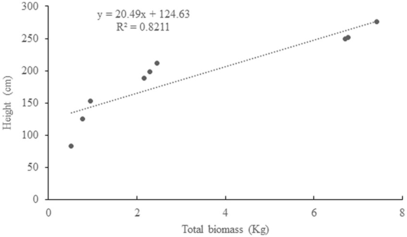
Keywords: semi-arid zone, drip irrigation system, food security, water management, composting
Citation: Traore B, Illiasso ADKT, Soulé M, Arzika MZ, Abdoussalam I, Moussa AA, Koudoussou IM and Moyo M (2024) Low-cost small-scale irrigation for developing an agroforestry system in the semi-arid zone of Niger: case of the apple of the Sahel (Ziziphus mauritiana L.). Front. Sustain. Food Syst. 8:1282235. doi: 10.3389/fsufs.2024.1282235
Edited by:
Sudhir Yadav, University of Queensland, AustraliaReviewed by:
Kapoury Sanogo, World Agroforestry Centre, KenyaAnshuman Singh, Indian Council of Agricultural Research (ICAR), India
Copyright © 2024 Traore, Illiasso, Soulé, Arzika, Abdoussalam, Moussa, Koudoussou and Moyo. This is an open-access article distributed under the terms of the Creative Commons Attribution License (CC BY). The use, distribution or reproduction in other forums is permitted, provided the original author(s) and the copyright owner(s) are credited and that the original publication in this journal is cited, in accordance with accepted academic practice. No use, distribution or reproduction is permitted which does not comply with these terms.
*Correspondence: Bouba Traore, boubasiditraore@yahoo.fr; bouba.traore@icrisat.org
†ORCID: Bouba Traore, https://orcid.org/0000-0002-4458-6440
Moussa Soulé, https://orcid.org/0000-0001-9125-1304
Abdourazak Alio Moussa, https://orcid.org/0000-0001-5261-9380
Martin Moyo, https://orcid.org/0000-0002-5496-7554
 Bouba Traore
Bouba Traore Aboubacar D. K. T. Illiasso
Aboubacar D. K. T. Illiasso Moussa Soulé
Moussa Soulé Mahaman Zaharadine Arzika
Mahaman Zaharadine Arzika Ibrahima Abdoussalam
Ibrahima Abdoussalam Abdourazak Alio Moussa
Abdourazak Alio Moussa Ibrahim Mana Koudoussou1
Ibrahim Mana Koudoussou1 